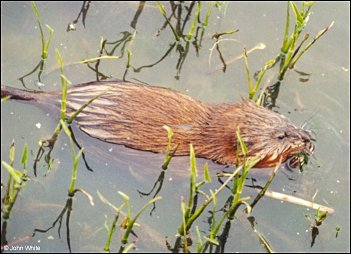

Sometimes we need something dramatically out of place to drive home to us how much things change over time. In El Paso, people who spend much time around irrigation drainage ditches or local bodies of water such as Feather Lake learn to accept Muskrats as a part of the local scene. It's also understood that these large rodents require permanent water for food and protection.
The city of Deming, far west of the Rio Grande Valley, is bordered by
the Mimbres River, represented by a riverbed wending its way south, dry except after
rare rains. Not exactly Muskrat habitat. South of Deming, the Mimbres skirts the
Florida Mountains before all signs of it disappear. Some years ago, high up on Baldy
Peak, a small number of fossils was recovered from dirt removed from a fissure by some
long-ago miner. Among these fossils were the unmistakable teeth of Muskrat, scores of
miles from any conceivable contemporary source. Armed with this knowledge and gazing
from the mountainside, the imagination clothes the now-arid drab landscape with a
meandering, green Mimbres Valley.

Contributor: Arthur H. Harris, Laboratory for Environmental Biology, Centennial Museum, University of Texas at El Paso.
Desert Diary is a joint production of the Centennial Museum and KTEP National Public Radio at the University of Texas at El Paso.

A Muskrat (Ondatra zibethicus) in its native habitat. ©John White.